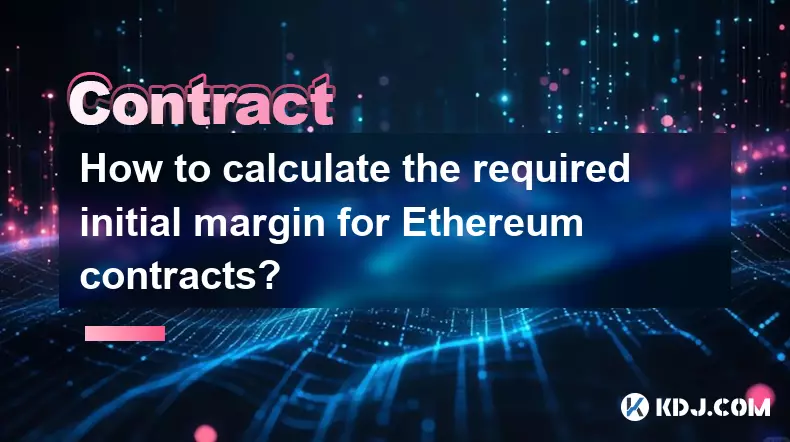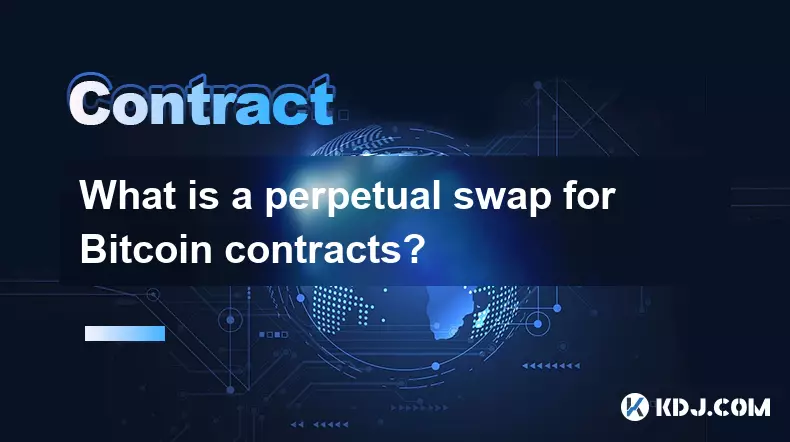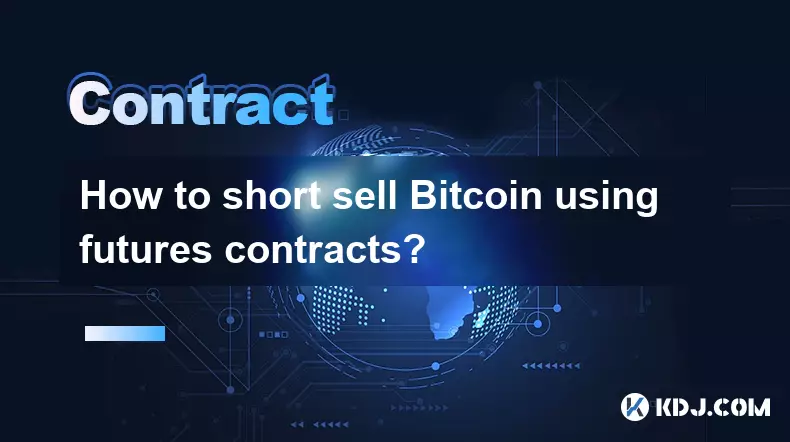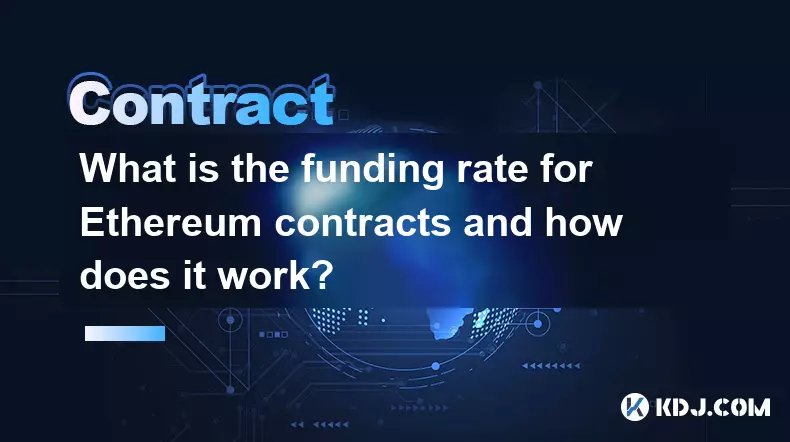-
 bitcoin
bitcoin $114320.977035 USD
-0.40% -
 ethereum
ethereum $4152.439985 USD
-1.75% -
 tether
tether $1.000111 USD
-0.04% -
 xrp
xrp $2.843037 USD
-1.63% -
 bnb
bnb $1013.349380 USD
-1.62% -
 solana
solana $208.362767 USD
-2.10% -
 usd-coin
usd-coin $0.999783 USD
0.00% -
 dogecoin
dogecoin $0.232559 USD
-1.00% -
 tron
tron $0.333491 USD
-1.09% -
 cardano
cardano $0.806310 USD
0.19% -
 hyperliquid
hyperliquid $45.023720 USD
-1.59% -
 ethena-usde
ethena-usde $1.000819 USD
-0.06% -
 chainlink
chainlink $21.241249 USD
-2.11% -
 avalanche
avalanche $30.035416 USD
-0.66% -
 stellar
stellar $0.364984 USD
-2.05%
How to calculate the required initial margin for Ethereum contracts?
Initial margin in Ethereum futures is the minimum capital required to open a leveraged position, calculated based on contract size, price, and leverage—varying by exchange and market conditions.
Oct 01, 2025 at 06:01 am

Understanding Initial Margin in Ethereum Futures
1. The initial margin for Ethereum futures contracts represents the minimum amount of capital a trader must deposit to open a leveraged position. This value is determined by the exchange and varies depending on the level of leverage applied. Higher leverage typically requires a smaller initial margin, increasing both potential gains and risks.
2. Exchanges calculate this margin based on the contract size and the current market price of Ethereum. For example, if one futures contract equals 0.1 ETH and Ethereum is trading at $3,000, the notional value is $300. With 10x leverage, the required initial margin would be $30.
3. Different platforms apply distinct risk models, incorporating volatility measures and liquidation thresholds into their calculations. These models help maintain platform stability during rapid price movements. Traders should review each exchange’s margin policy before initiating positions.
4. Some derivatives exchanges use a tiered margin system where larger positions require proportionally higher margins to discourage excessive risk-taking. This structure adjusts the margin rate based on the total exposure, promoting responsible trading behavior.
5. Maintenance margin levels are also defined alongside initial requirements. Falling below this threshold triggers a margin call or automatic liquidation. Monitoring account equity relative to these benchmarks is essential for sustaining open positions.
Factors Influencing Margin Requirements
1. Market volatility has a direct impact on margin calculations. During periods of high price fluctuation, exchanges may increase margin requirements to protect against sudden liquidations. This adjustment helps mitigate systemic risk across the platform.
2. Leverage selection is entirely under the trader’s control but significantly affects the initial margin. Choosing 50x leverage reduces the required upfront capital compared to 5x, though it amplifies the chance of liquidation due to minor adverse price moves.
3. Contract type plays a role as well. Perpetual swaps often have different margining rules than quarterly futures. Funding rates in perpetuals do not alter initial margin but influence holding costs over time, indirectly affecting available margin balance.
4. Regulatory standards in certain jurisdictions mandate minimum margin levels regardless of user preference. Platforms operating in compliant regions enforce these rules uniformly across all users to meet legal obligations.
5. Asset liquidity influences how exchanges set margin parameters. Highly liquid markets like major Ethereum pairs may allow lower margins due to faster execution speeds and tighter spreads, reducing counterparty risk.
Step-by-Step Calculation Method
1. Identify the contract size specified by the exchange. This could be expressed in ETH units or USD value. For instance, Binance might define a BTCUSD contract as 0.001 BTC, while an ETHUSD contract could be 0.1 ETH.
2. Multiply the contract size by the current spot price of Ethereum to determine the notional value. If ETH trades at $2,800 and the contract size is 0.05 ETH, the notional value equals $140 per contract.
3. Divide the notional value by the selected leverage to compute the initial margin. At 20x leverage, $140 divided by 20 results in $7 required per contract. This figure represents the capital needed to initiate the trade.
4. Account for additional fees such as taker fees or funding payments that may reduce available margin balance shortly after entry. While not part of the formal calculation, these costs affect practical margin management.
5. Always verify the result using the exchange's built-in margin calculator when available, as some platforms include buffer zones or dynamic adjustments not captured in basic formulas.
Frequently Asked Questions
What happens if my margin falls below the maintenance level?If your equity drops below the maintenance margin threshold, the exchange will issue a margin call. Failure to deposit additional funds leads to partial or full liquidation of your position to cover potential losses.
Can I change the leverage after opening a position?Most exchanges permit leverage adjustment on existing positions, provided the new setting doesn’t immediately trigger liquidation. Increasing leverage without adding funds can dangerously reduce your buffer against price swings.
Do isolated and cross-margin modes affect initial margin differently?Yes. In isolated margin mode, the initial margin is fixed and limited to a specific amount allocated to the position. Cross-margin uses the entire wallet balance as collateral, potentially reducing the need for large upfront deposits but exposing more funds to risk.
Are there differences in margin requirements between centralized and decentralized exchanges?Centralized exchanges typically offer standardized, transparent margin rules with advanced risk controls. Decentralized platforms may rely on smart contract-based mechanisms with less flexibility in leverage options and stricter collateral ratios due to settlement finality constraints.
Disclaimer:info@kdj.com
The information provided is not trading advice. kdj.com does not assume any responsibility for any investments made based on the information provided in this article. Cryptocurrencies are highly volatile and it is highly recommended that you invest with caution after thorough research!
If you believe that the content used on this website infringes your copyright, please contact us immediately (info@kdj.com) and we will delete it promptly.
- BlockDAG, DOGE, HYPE Sponsorship: Crypto Trends Shaping 2025
- 2025-10-01 00:25:13
- Deutsche Börse and Circle: A StableCoin Adoption Powerhouse in Europe
- 2025-10-01 00:25:13
- BlockDAG's Presale Buzz: Is It the Crypto to Watch in October 2025?
- 2025-10-01 00:30:13
- Bitcoin, Crypto, and IQ: When Genius Meets Digital Gold?
- 2025-10-01 00:30:13
- Stablecoins, American Innovation, and Wallet Tokens: The Next Frontier
- 2025-10-01 00:35:12
- NBU, Coins, and Crypto in Ukraine: A New Yorker's Take
- 2025-10-01 00:45:14
Related knowledge

How to calculate the required initial margin for Ethereum contracts?
Oct 01,2025 at 06:01am
Understanding Initial Margin in Ethereum Futures1. The initial margin for Ethereum futures contracts represents the minimum amount of capital a trader...

What is a perpetual swap for Bitcoin contracts?
Oct 01,2025 at 08:18am
Understanding Perpetual Swaps in Bitcoin Trading1. A perpetual swap is a type of derivative contract that allows traders to speculate on the price of ...

What is the best platform for trading SOL contracts?
Oct 01,2025 at 06:36am
Understanding the Role of Decentralized Exchanges in Modern Crypto Trading1. Decentralized exchanges (DEXs) have reshaped how traders interact with di...

How to short sell Bitcoin using futures contracts?
Oct 01,2025 at 02:54am
Understanding the Role of Decentralized Exchanges in Crypto Trading1. Decentralized exchanges (DEXs) have become a cornerstone of the cryptocurrency e...

Are PEPE contracts a good way to trade volatility?
Oct 01,2025 at 04:18am
Understanding PEPE Contracts in the Cryptocurrency Market1. PEPE contracts, derived from the broader meme coin movement, have gained attention due to ...

What is the funding rate for Ethereum contracts and how does it work?
Oct 01,2025 at 10:54am
Funding Rate Mechanism in Ethereum Derivatives1. The funding rate is a periodic payment exchanged between long and short positions in perpetual future...

How to calculate the required initial margin for Ethereum contracts?
Oct 01,2025 at 06:01am
Understanding Initial Margin in Ethereum Futures1. The initial margin for Ethereum futures contracts represents the minimum amount of capital a trader...

What is a perpetual swap for Bitcoin contracts?
Oct 01,2025 at 08:18am
Understanding Perpetual Swaps in Bitcoin Trading1. A perpetual swap is a type of derivative contract that allows traders to speculate on the price of ...

What is the best platform for trading SOL contracts?
Oct 01,2025 at 06:36am
Understanding the Role of Decentralized Exchanges in Modern Crypto Trading1. Decentralized exchanges (DEXs) have reshaped how traders interact with di...

How to short sell Bitcoin using futures contracts?
Oct 01,2025 at 02:54am
Understanding the Role of Decentralized Exchanges in Crypto Trading1. Decentralized exchanges (DEXs) have become a cornerstone of the cryptocurrency e...

Are PEPE contracts a good way to trade volatility?
Oct 01,2025 at 04:18am
Understanding PEPE Contracts in the Cryptocurrency Market1. PEPE contracts, derived from the broader meme coin movement, have gained attention due to ...

What is the funding rate for Ethereum contracts and how does it work?
Oct 01,2025 at 10:54am
Funding Rate Mechanism in Ethereum Derivatives1. The funding rate is a periodic payment exchanged between long and short positions in perpetual future...
See all articles










































































